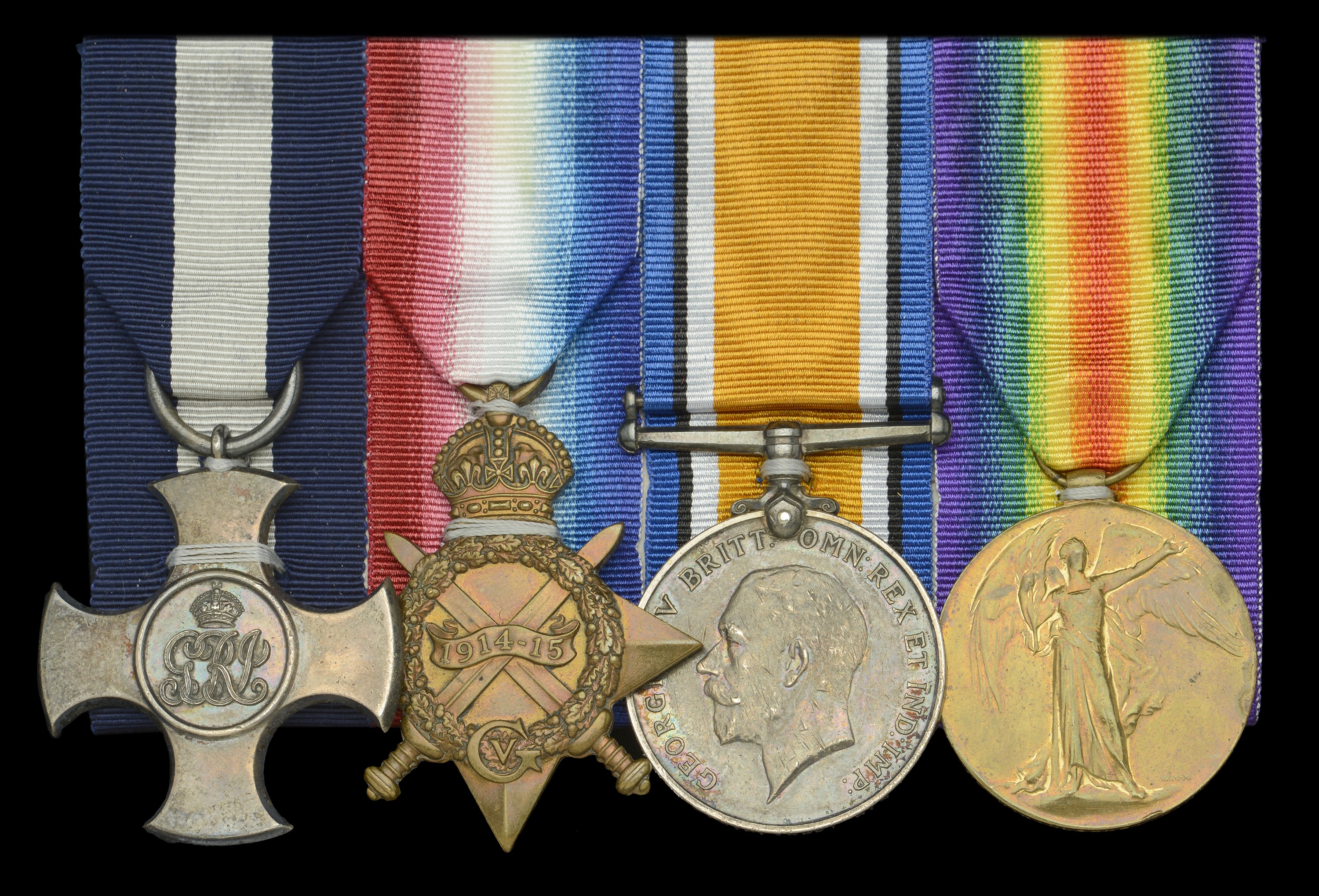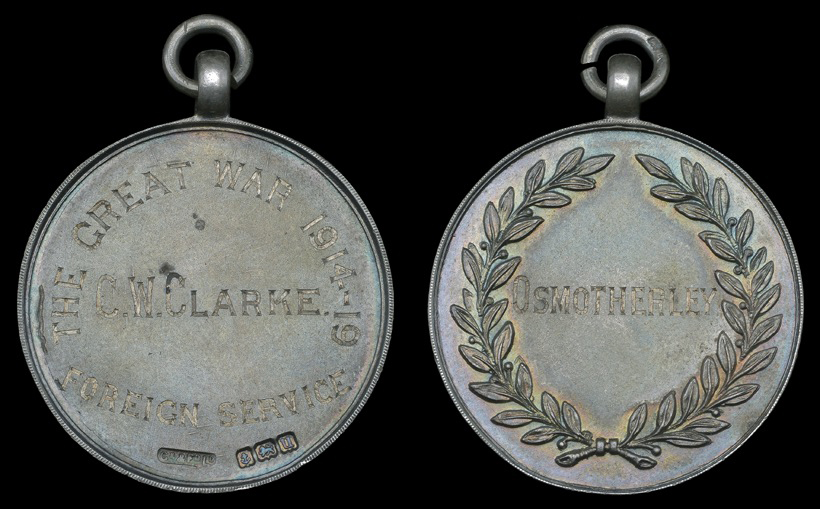The extremely rare Russia 1919 operations D.S.C. group of four awarded to Gunner C. W. Clarke, Royal Navy, who was decorated for his command of the armed-barge Suffolk in the Kama River Flotilla, Siberia Distinguished Service Cross, G.V.R., hallmarks for London 1919; 1914-15 Star (235903 C. W. Clarke, P.O., R.N.); British War and Victory Medals (Gnr. C. W. Clarke, R.N.) mounted court-style for display, together with Osmotherley Great War Tribute Medal, silver, named to ‘C. W. Clarke, The Great War 1914-19 Foreign Service’, very fine and better (5) £3,000-£4,000 --- Importation Duty This lot is subject to importation duty of 5% on the hammer price unless exported outside the UK --- --- Provenance: R. C. Witte Collection, Dix Noonan Webb, March 2013. D.S.C. London Gazette 8 March 1920: ‘For distinguished services in command of the river steamer Suffolk operating on the Kama River.’ Cedric William Clarke was born at Northallerton, Yorkshire, in December 1889, and entered the Royal Navy as a Boy 2nd Class in February 1906. A Leading Seaman in battleship H.M.S. Prince George by the outbreak of hostilities in August 1914, he remained similarly employed until March 1916, in which period he was advanced to Petty Officer and witnessed action in the Dardanelles. Having then returned to a shore appointment back in the U.K., Clarke served in another battleship, the Albion, in January-June 1917, in which latter month he was commissioned as a Gunner, R.N. and in this latter rank he joined the cruiser H.M.S. Kent in May 1918, the commencement of his Siberian sojourn. Ordered to Vladivostock in January 1919, to relieve her consort Suffolk, Kent was approached for volunteers to man an oil-driven tug and a barge in support of operations on the River Kama in Siberia, and Clarke was among the chosen handful of naval personnel to support a larger force of Marines, the whole under the command of Captain T. H. Jameson, R.M.L.I. Kama River Flotilla The oil-driven tug was duly renamed Kent and the barge Suffolk, the former being armed with four 12-pounders and manned by a volunteer crew of 24, and the latter with a 6-inch gun and a crew of nine, of which Clarke was placed in command. Joining their new “ships” at Perm in late April 1919, where they came under the overall command of Admiral Smirnoff, C.M.G., C.O. of the Kama River Flotilla, the Marines and Bluejackets were quickly in action as part of the Third Division of the Flotilla, under Captain Fierdoroff, in May and June, engaging enemy gunboats and carrying out valuable shore bombardments - a story vividly recalled in Captain Jameson’s Expedition to Siberia 1919. It is clear from Jameson’s account of the expedition that Clarke’s command, the Suffolk, was regularly in action, more so than the Kent, not least in the closing days of the Third Division’s part in the campaign in late June - on the 26th Suffolk engaged the enemy in Veltanka district, and again the next day at the village of Stralka, where she routed large numbers of the “Bolos” at close range - in all she fired 256 rounds and, having expended her ammunition, was recalled to Perm, arriving at Motavaileka Works on the 28th. The Marines and bluejackets were now ordered to dismantle their “ships” and load the resultant 225 tons of material on to railway trucks, a task made yet harder by the threat that Perm would fall shortly to the “Bolos” - in fact confusion reigned everywhere and the local railway station was overflowing with refugees. Kent and Suffolk were then sunk by permission of Admiral Smirnoff. Commandeering a locomotive from the repair shop - much to the annoyance of the Russians - Captain Jameson and his men eventually chugged out of Perm Station in the early morning of 29 June, a total of 37 of all ranks being crammed into two wooden trucks. And it would be 52 days - via Omsk and many adventures - that the exhausted party finally reached Vladivostock on 8 August, when they were taken on board the Carlisle: transferring at Shanghai to the Colombo, they finally reached England on 10 November 1919. Jameson was awarded the D.S.O., Clarke and his opposite number in the Kent D.S.C.s, and eight Petty Officers and ratings the Naval M.S.M., in addition to a single D.S.M. to Sergeant Alfred Taylor, R.M.L.I. of the Suffolk. Remaining active between the Wars, Clarke was appointed Commissioned Gunner in December 1926, while serving in the Hood, and to Lieutenant in November 1937, while serving in the Royal Sovereign. Next removing to the Devonport establishment Drake in April 1938, where he was still serving on the renewal of hostilities in the following year, he later removed to Malagas, the Fleet Air Arm station in South Africa, and was placed on the Retired List as a Lieutenant-Commander in 1946. He died in January 1951. Sold with copied record of service and R.M. Historical Society reprint of Captain Jameson’s Expedition to Siberia 1919.









